| | | |
Archive
| « November 2009 » |
|---|
| Mo | Tu | We | Th | Fr | Sa | Su |
|---|
| | 1 | | 2 | 3 | 4 | 5 | 6 | 7 | 8 | | 9 | 10 | 11 | 12 | 13 | 14 | 15 | | 16 | 17 | 18 | 19 | 20 | 21 | 22 | | 23 | 24 | 25 | 26 | 27 | 28 | 29 | | 30 | |
|
| | | |
|
|
|
|
|
|
|
30 November 2009 | Views: 3802 | Comments: 2 |
|
|

Experience of nomadic life
The map of the Todzha district of Republic Tuva was spread out over the entire wall of the socio-economic department of the administration. It did not show highways or roads for cars, none with covered tops neither without it. Only four canvas tents with chimney pipes of “burzhuyka” stoves sticking out remind us that people live here. Everything else is a painting without artefacts. 19th century ethnographers used to describe the common nomad grounds of several families, forming a single camp – aal – as a nomadic neighbor community. It could consist of relatives, or of people without any blood ties.
|
|
|
|
|
|
Anastasia Veshchikova, Center of Asia, translated by Heda Jindrak |
|
|
|
|
|
|
|
|
19 November 2009 | Views: 5075 | Comments: 1 |
|
|
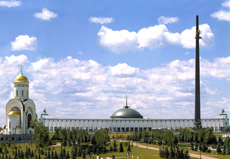 In May 2010, in Moscow, on the eve of Day of Victory, an exhibition will open concerning the role of Tuva in the Great Patriotic War. This was announced by the head of the republic, Sholban Kara-ool, at the meeting dedicated to the Day of National Unity. In May 2010, in Moscow, on the eve of Day of Victory, an exhibition will open concerning the role of Tuva in the Great Patriotic War. This was announced by the head of the republic, Sholban Kara-ool, at the meeting dedicated to the Day of National Unity.
At the recommendation of the Premier, the agreement about the placement of the Tuvan exposition in the museum complex at Poklonnaya mountain was reached with the administration of the museum.
|
|
|
|
|
|
Dina Oyun, translated by Heda Jindrak |
|
|
|
|
|
|
|
|
11 November 2009 | Views: 4690 | Comments: 0 |
|
|
 1000 Buddha statuettes were on exhibit in the prayer hall of the main temple (khuree) of Tuva during the great Buddhist Holy Days. These statuettes were made in Nepal under the supervision of the Nepal lama Tuge Rinpoche. The figurines were made for the “Ustuu-Khuree” monastery which was destroyed in the 30’s of last century. They will be placed in the Upper Chadan khuree after the work on the new temple, which is an exact copy of the destroyed temple, is finished. 1000 Buddha statuettes were on exhibit in the prayer hall of the main temple (khuree) of Tuva during the great Buddhist Holy Days. These statuettes were made in Nepal under the supervision of the Nepal lama Tuge Rinpoche. The figurines were made for the “Ustuu-Khuree” monastery which was destroyed in the 30’s of last century. They will be placed in the Upper Chadan khuree after the work on the new temple, which is an exact copy of the destroyed temple, is finished.
|
|
|
|
|
|
info from savetibet.ru translated by Heda Jindrak |
|
|
|
|
|
|
|
|
9 November 2009 | Views: 5415 | Comments: 0 |
|
|
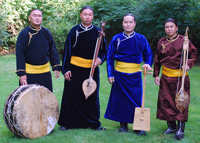 The Tuvan throat singers Alash are flying to the U.S. from reindeer country to perform “Jingle Bells” and other Yuletide favorites with the legendary American group Béla Fleck & the Flecktones, to promote the Flecktones' Grammy-winning CD
Jingle All the Way. This lively and innovative album presents holiday tunes like you’ve never heard them before. The buzzy sounds of throat singing provide a surprise element in several songs, including the traditional Tuvan song “Dyngyldai” ingeniously interwoven with the English Christmas carol “What Child Is This?” (See it on YouTube). By the way, in case you’re wondering, "dyngyldai" is a Tuvan nonsense word that has no translation. The Tuvan throat singers Alash are flying to the U.S. from reindeer country to perform “Jingle Bells” and other Yuletide favorites with the legendary American group Béla Fleck & the Flecktones, to promote the Flecktones' Grammy-winning CD
Jingle All the Way. This lively and innovative album presents holiday tunes like you’ve never heard them before. The buzzy sounds of throat singing provide a surprise element in several songs, including the traditional Tuvan song “Dyngyldai” ingeniously interwoven with the English Christmas carol “What Child Is This?” (See it on YouTube). By the way, in case you’re wondering, "dyngyldai" is a Tuvan nonsense word that has no translation.
|
|
|
|
|
|
|
|
|
|
|
|
|
8 November 2009 | Views: 3639 | Comments: 0 |
|
|
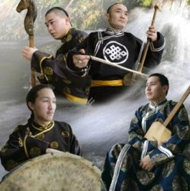 In Ulan-Ude, Buryatia, the 4th International Festival-contest of throat-singing, “The Breath of the Earth” just took place. In Ulan-Ude, Buryatia, the 4th International Festival-contest of throat-singing, “The Breath of the Earth” just took place.
Throat singers from Khakassia, Tuva, Altai, Khabarovsk and Trans-Baikal regions, Irkutsk region, Buryatia, and Mongolia participated in the contest.
Diplomas of th 1st order were received by Yevgenii Ulugbashev (Khakassia), and the Tuvan folklore group “Arzhaan” (Tuva, leader Opuyla Artysh), as the information portal “Baikal24” announced.
|
|
|
|
|
|
Baikal24, translated by Heda Jindrak |
|
|
|
|
|
|
|
|
7 November 2009 | Views: 4256 | Comments: 0 |
|
|
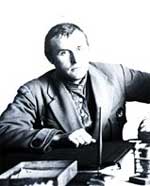 In Tuva, Sergei Kuzmich Kochetov is a legendary personality. The village where he spent his youth and one of the central streets in Kyzyl bear his name. He was a participant in three wars – The World War I, the Civil War, and the Great Patriotic War. He fought at Moscow, battled at Kursk, liberated Kiev. When he returned to Kyzyl, he became the first delegate to the Supreme Soviet of USSR from the republic. Sergei Kochetov was born on November 7, 1894 in the Kodybai village of Minusinsk district. In Tuva, Sergei Kuzmich Kochetov is a legendary personality. The village where he spent his youth and one of the central streets in Kyzyl bear his name. He was a participant in three wars – The World War I, the Civil War, and the Great Patriotic War. He fought at Moscow, battled at Kursk, liberated Kiev. When he returned to Kyzyl, he became the first delegate to the Supreme Soviet of USSR from the republic. Sergei Kochetov was born on November 7, 1894 in the Kodybai village of Minusinsk district.
|
|
|
|
|
|
Dina Oyun, translated by Heda Jindrak |
|
|
|
|
|
|
|
|
6 November 2009 | Views: 3752 | Comments: 0 |
|
|
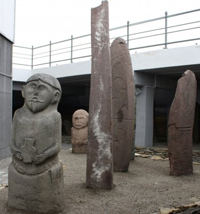 The ancient stone images that were brought to the National Museum of Tuva over the years from different corners of the republic are now on view by all those who wish to see them. In the stelarium of the museum, which is located on the ground floor, fifty-five stone figures are exhibited in chronologic order, starting with the Bronze Age to the Mongol period of Tuva. These are stones with images of animals, masks-faces, reindeer stones, stelae with ancient Turkic runic writing, stone human figures (kizhi-kozhee). There are also reference materials, archeological map of Tuva, materials on the Uighur fortress Por-Bazhyn, and on towns of the Mongol period of Tuva. The ancient stone images that were brought to the National Museum of Tuva over the years from different corners of the republic are now on view by all those who wish to see them. In the stelarium of the museum, which is located on the ground floor, fifty-five stone figures are exhibited in chronologic order, starting with the Bronze Age to the Mongol period of Tuva. These are stones with images of animals, masks-faces, reindeer stones, stelae with ancient Turkic runic writing, stone human figures (kizhi-kozhee). There are also reference materials, archeological map of Tuva, materials on the Uighur fortress Por-Bazhyn, and on towns of the Mongol period of Tuva.
|
|
|
|
|
|
museumrt.ru, translated by Heda Jindrak |
|
|
|
|
|
|
|
|
2 November 2009 | Views: 3903 | Comments: 0 |
|
|
 The Tuvan ethno-group “Huun-Huur-Tu”, and Tuvan-Austrian singer Sainkho continue with their joint concert experiments on the stage of Hong Kong, after which tehey are expected in Oslo, Norway. The tandem of the two famous projects was introduced on October 11 in Russia, in the Moscow House of Music, on the day of the 65th Anniversary of Tuva’s entering the system of Soviet Union. The Tuvan ethno-group “Huun-Huur-Tu”, and Tuvan-Austrian singer Sainkho continue with their joint concert experiments on the stage of Hong Kong, after which tehey are expected in Oslo, Norway. The tandem of the two famous projects was introduced on October 11 in Russia, in the Moscow House of Music, on the day of the 65th Anniversary of Tuva’s entering the system of Soviet Union.
|
|
|
|
|
|
Dina Oyun, translated by Heda Jindrak |
|
|
|
|
|
|
|
|
1 November 2009 | Views: 4207 | Comments: 0 |
|
|
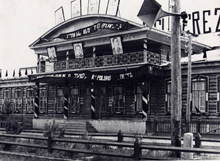 A meeting dedicated to the victims of political repressions was held by the Monument of the Undefeated Arat in the capital of Tuva on October 30. 10-20 meters from the monument, there is a one-story grey wooden building, which today contains a museum of political repressions. Its history is closely related to this tragic page in the history of Tuva. In the basement of this house, by the burning-hot stove, confessions were extracted from the accused. A meeting dedicated to the victims of political repressions was held by the Monument of the Undefeated Arat in the capital of Tuva on October 30. 10-20 meters from the monument, there is a one-story grey wooden building, which today contains a museum of political repressions. Its history is closely related to this tragic page in the history of Tuva. In the basement of this house, by the burning-hot stove, confessions were extracted from the accused.
|
|
|
|
|
|
Dina Oyun, translated by Heda Jindrak |
|
|
|
|
|
|
